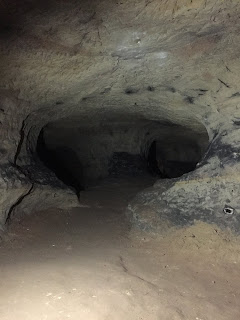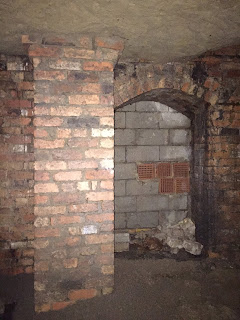Nottingham is known as the City of Caves. It was built into a sandstone ridge and there are over 800 known caves in the city. Earlier this month was the Nottingham Underground Festival, where they open some of the caves that are generally closed to the public for tours. We did two, one called the Peel Street Caves, also known as Mammoth Caves. The second was a cave system they have regular tours for, but we did an evening ghost tour.
This is the map for the first one we went into. It's called Mammoth because of how big it is, obviously. And we got to go through pretty much that whole map! We had to carry flashlights (torches) and wear hardhats. There was no internal lighting.
Here's how you enter. Just a door with a couple rickety looking padlocks on it, nothing to see here. I'm honestly surprised they don't have more people breaking in to squat or party. This door was created as an entrance when they converted it to an air raid shelter during World War II. The historical entrance was on another road, by way of a shop. Way back when, the shopkeeper owned the cave, because he owned the building with access to the entrance. With 800+ caves in town, Lyle and I figure it should be pretty easy to find some property that will make us cave-owners. #newlifegoals
That's our guide. I don't know what his official title is, but he's very familiar with this cave and takes a lot of pride in it. He's clearly spent a lot of time down there.
You can see it got quite narrow and there were a lot of turns as you go into it. And they reinforced the ceiling with metal for when it was turned into a shelter.
You can imagine the bathroom situation wasn't the best. But at least they had them!
The women's had some semblance of stalls, which have crumbled at this point. The men's was just an open room. A few hundred people could fit down here, but not comfortably at all. There's hardly anywhere to sit, just some "benches" here and there carved into the walls. I imagine it would feel very claustrophobic, but, of course, better than the alternative of being outside during an air raid.
Off of the women's bathroom they walled off a section that opened up onto this. That was their way of preserving this painting, which they're pretty sure is the earliest known work of Andrew MacCallum, a Nottingham-born artist of some renown. (He has some works in the Tate, and in 1875 he was commissioned by Queen Victoria to paint five views near Balmoral. You have to be pretty good to be comissioned by a queen, I assume.) In case you can't tell what this is, which I couldn't for a long time, it's a figure lying on top of a tomb, or a tomb effigy. They think it was done sometime in the 1840s when he was in art school.
This is another one they presume was his, but it has been added to by various visitors over the years.
This is an older entrance that has been walled up. Apparently college kids used to come down here to party before it was properly sealed off. How are there not more stories of people coming down here and getting lost and dying?! The owners of the building above also used to do a lot of "fly-tipping", or illegal dumping, here too.
The cave was originally carved out for the sand, which was used by the glassworks industry. It has also been used by budding artists, shopkeepers for storage of fruits and flowers and as an air raid shelter. It was a very cool tour and much more thorough than I expected. We were down there about 2 hours.
The second tour was the ghost tour, which was fairly disappointing. The stories weren't really specific to that cave, and they weren't that scary even if they were.
These ancient caves - known as the City of Caves - were likely used for housing as early as the 11th century. Many were inhabited until 1845, when the St. Mary’s Enclosure Act banned the rental of cellars and caves as homes for the poor. (Though that probably didn't stop everyone.) Since then they have been used as store rooms, factories, pub cellars and air raid shelters. One of the cooler, non-ghostly stories was that Luddites (a secret oath-based organization of English textile workers in the 19th century, a radical faction of which destroyed textile machinery as a form of protest) would meet in the caves under pubs. They would have kids up on the streets acting as lookouts, and when they saw police coming, because it was a crime punishable by death to even conspire to destroy machinery, the kids would drop pebbles down a hole that went through to the cave meeting room. The conspirators would then run up into the pub and grab a pint, hopefully before the police entered.
I only took two photos down there, and while Lyle and I were out to eat after the tour, I jokingly said I should look at them to see if I caught any ghosts.
Turns out I caught something! None of my other cave photos turned out like that, so I don't know what happened, but it's certainly very interesting.
That's it for caves! For now, anyway. I'm sure we'll make our way through whatever ones we can while we're here.
Next adventure: an overnight trip to London.











I want to read a new story every day. I request more ghost pics, more caves and more of your voice because it's the best.
ReplyDelete